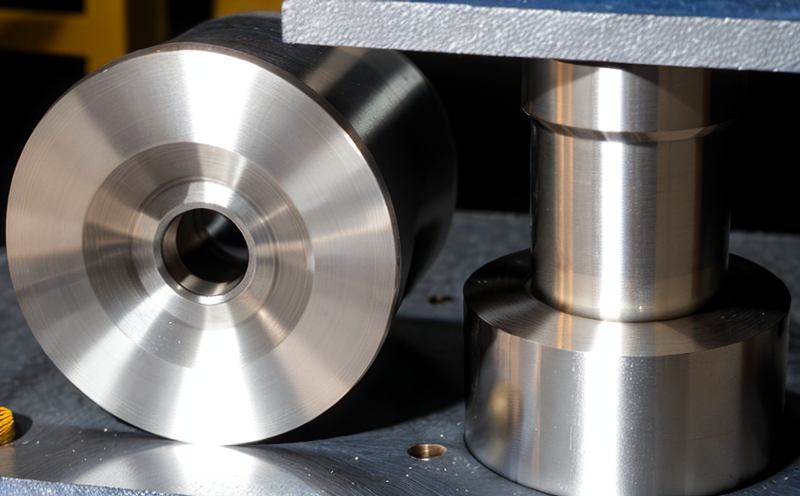ISO 783 Compression Testing of Nanostructured Metallic Specimens
The ISO 783 compression testing standard is specifically tailored to evaluate the mechanical properties of metallic materials, including nanostructured metals and alloys. This test method provides a standardized approach for determining the compressive strength and modulus of elasticity of metallic specimens under defined loading conditions. When applied to nanostructured metals and alloys, this technique offers critical insights into how these advanced materials behave under stress.
Nanostructured metallic materials are characterized by their unique microstructure at the nanoscale level, which can significantly influence mechanical properties such as strength, ductility, and hardness. The compression test is particularly relevant for nanostructured metals because it can reveal the effects of grain size, orientation, and internal structure on material performance.
The test involves compressing a cylindrical or rectangular specimen to failure while recording force-displacement data. Specimen preparation is crucial; it requires precision cutting using specialized techniques like focused ion beam (FIB) milling or mechanical grinding followed by polishing. The surface finish must be uniform to ensure accurate measurements without artificial stress concentrations.
The testing apparatus typically consists of a compression tester capable of applying controlled loads and measuring displacement with high accuracy. Strain gauges may also be used to measure lateral strains during the test. Specimens are aligned parallel to the direction of loading unless otherwise specified in the ISO 783 protocol.
Post-test analysis includes examining fractured surfaces using scanning electron microscopy (SEM) or transmission electron microscopy (TEM). This helps identify failure mechanisms such as shear bands, void formation, or slip planes within the nanostructured material. The results provide valuable data for optimizing manufacturing processes and improving product design.
The ISO 783 protocol ensures reproducibility across different laboratories by specifying exact loading rates, temperature conditions, and environmental controls. Compliance with these standards is essential for validating test results and ensuring comparability between studies.
Understanding the behavior of nanostructured metals under compression allows researchers and manufacturers to develop stronger, lighter components for various industries including aerospace, automotive, electronics, and defense. By leveraging this testing methodology, organizations can enhance their understanding of material performance at the nanoscale level, leading to innovations in product design and manufacturing.
Compliance with ISO 783 is particularly important for regulatory purposes or when participating in international collaborations where consistent testing methods are required. It also supports R&D efforts aimed at advancing knowledge about how nanostructured metals interact with external forces.
Benefits
The ISO 783 compression test offers numerous advantages for those working with nanostructured metallic materials:
- Informed Decision Making: Provides reliable data to guide decisions regarding material selection and process optimization.
- Consistency Across Laboratories: Ensures consistent results regardless of where the tests are conducted, facilitating collaborative research efforts.
- Rapid Prototyping: Allows for quick evaluation of new materials or modifications before full-scale production begins.
- Regulatory Compliance: Meets regulatory requirements set forth by international standards bodies like ISO and ASTM.
- Innovation Facilitation: Supports ongoing development of cutting-edge technologies in fields such as energy storage, medical devices, and space exploration.
Industry Applications
| Industry Sector | Description of Application |
|---|---|
| Aerospace & Defense | Evaluating lightweight, high-strength materials for aircraft and missile components. |
| Automotive | Assessing structural integrity of vehicle parts made from advanced alloys. |
| Consumer Electronics | Testing durability of electronic device casings fabricated using nanostructured metals. |
| Medical Devices | Ensuring safety and performance of implantable devices constructed from specific metallic alloys. |
| Energy Storage | Characterizing electrode materials for improved battery efficiency and lifespan. |
The ISO 783 compression test is indispensable in these sectors due to its ability to provide detailed insights into the mechanical properties of nanostructured metallic specimens. This knowledge translates directly into enhanced product performance, reliability, and safety across multiple applications.
Quality and Reliability Assurance
The ISO 783 compression test plays a pivotal role in ensuring quality and reliability within the manufacturing process of nanostructured metals. By providing precise measurements of compressive strength and modulus, this method allows manufacturers to monitor production parameters closely, identifying any deviations from desired specifications early on.
For instance, if a batch of nanostructured steel exhibits lower than expected compressive strength, further investigation using SEM or TEM could reveal issues such as uneven grain distribution or contamination. Addressing these problems promptly can prevent the production of substandard products and costly recalls later down the line.
In addition to quality control, ISO 783 also supports reliability engineering by helping predict how nanostructured metals will perform over time under real-world conditions. For example, understanding the fatigue behavior of a certain alloy through this test can inform design choices that extend the service life of components used in harsh environments like space or deep sea.
Moreover, compliance with ISO 783 helps establish trust among stakeholders including customers, investors, and regulatory authorities. It demonstrates a commitment to excellence and adherence to best practices in materials testing.





